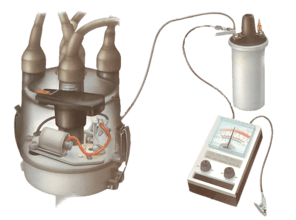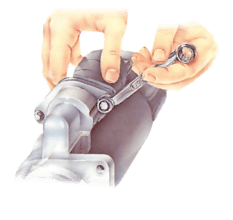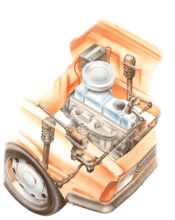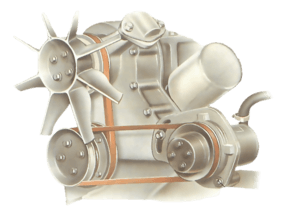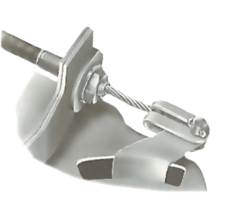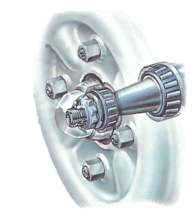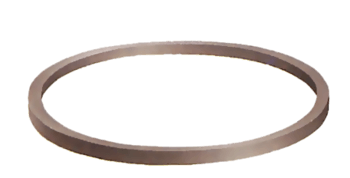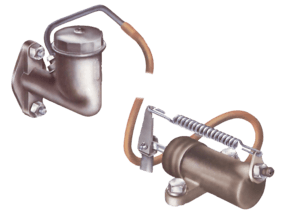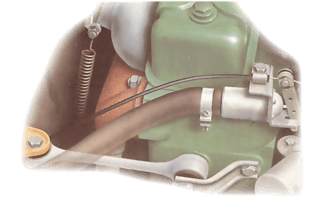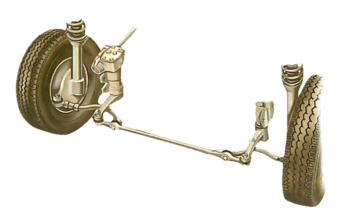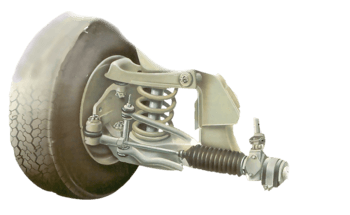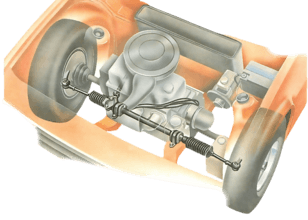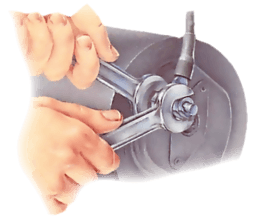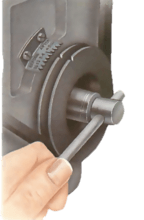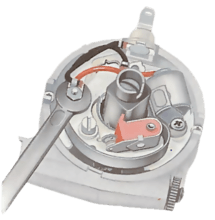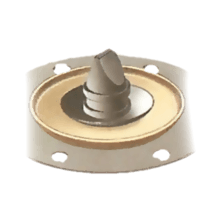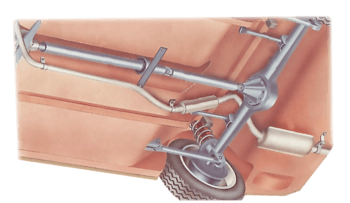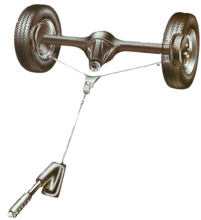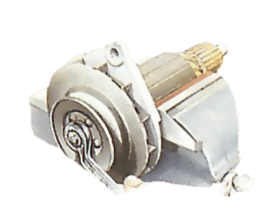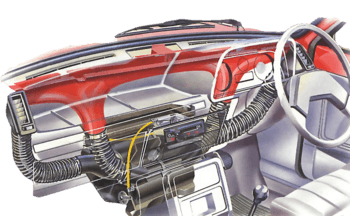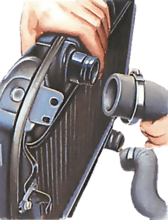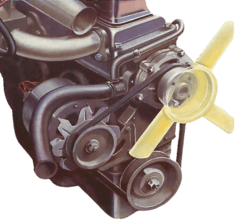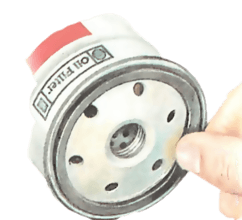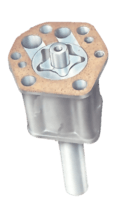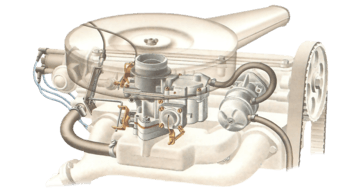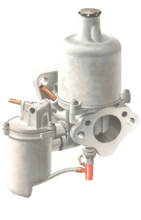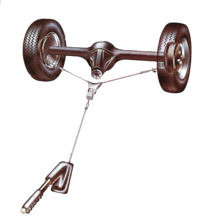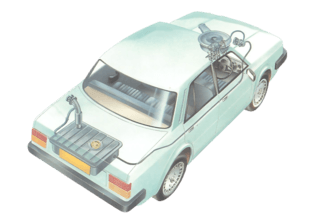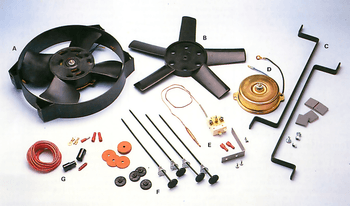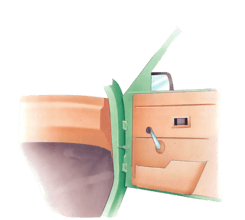Clés
Good spanners are forged from chrome vanadium. It is not worth buying cheap ones, which are likely to widen under pressure. If you want more than two or three ring or open-ended spanners, it is usually cheaper to buy a set, with probably five or eight spanners of metric, AF or BA sizes.
Most spanners are double ended, with consecutive sizes increasing mainly by 1mm or sixteenths of an inch(AF) at each end. Some spanners have one size duplicated on the spanner of the next consecutive size so that two nuts of the same size can be turned at the same time.
There is no clear distinction between a spanner and a wrench. Different tool catalogues may use either term for the same tool. The word wrench is also sometimes used to describe grips.

Open-ended spanner
Because it does not grip all round a nut, an open-ended spanner is likely to slip and round off the edges of a tight nut unless it is an exact fit.
Where possible, use a ring spanner to loosen a nut, then an open-ended spanner, which is faster to use, to undo it if the nut is still more than finger tight.

Combination spanner
A combination spanner has a ring at one end and is open-ended at the other. Both ends are the same size, so the ring end (Which may be slightly offset) can be used to loosen the nut and the spanner turned to undo the nut faster with the other open end.
Because only one size is covered in each spanner, a set of combination spanners is relatively more expensive than a set of individual ring or open-ended spanners.

Adjustable spanner
An adjustable spanner is open ended, with one movable jaw that can be screwed in or out to fit a number of nut sizes. Use it only if the correct ring or open-ended spanner is not available.
Buy one that gives a wider opening than your largest ring or open-ended spanner. A 300mm crescent-shaped spanner is likely to have a maximum opening of 34mm. Make sure the jaws fit well together, with no free play or any tendency to rock or back off when pressure is applied.
Unless properly fitted on a nut, the spanner may be strained, or slip and round off the nut edges. Fit the spanner jaws as far on to the nut as possible, and position it so that the main pressure is exerted on the fixed jaw.
A wrench (also called a spanner) is a tool used to provide grip and mechanical advantage in applying torque to turn objects—usually rotary fasteners, such as nuts and bolts—or keep them from turning.
In British English, spanner is the standard term. The most common shapes are called open-ended spanner and ring spanner. The term wrench is generally used for tools that turn non-fastening devices (e.g. tap wrench and pipe wrench), or may be used for a monkey wrench - an adjustable spanner.
In American English, wrench is the standard term. The most common shapes are called open-end wrench and box-end wrench. In American English, spanner refers to a specialized wrench with a series of pins or tabs around the circumference. (These pins or tabs fit into the holes or notches cut into the object to be turned.) In American commerce, such a wrench may be called a spanner wrench to distinguish it from the British sense of spanner.
Higher quality wrenches are typically made from chromium-vanadium alloy tool steels and are often drop-forged. They are frequently chrome-plated to resist corrosion and ease cleaning.
Hinged tools, such as pliers or tongs, are not generally considered wrenches in English, but exceptions are the plumber wrench (pipe wrench in British English) and Mole wrench (sometimes Mole grips in British English).
Read more on Wikipedia
Cet outil est utilisé dans
Lors de la pose de nouveaux points de contact dans le distributeur, la façon normale de vérificat...
Remove the starter motor from the car (See Checking and replacing starter-motor brushes). The bo...
Places where vital components are mounted on the bodywork or chassis should be inspected at leas...
La courroie qui entraîne une pompe de fluide hydraulique de direction est assistée généralement ...
The clutch cable has a steel-wire inner core sliding inside an outer sheath. It should last at l...
Wheel bearings need periodic checking - and adjusting if necessary - usually at 12,000 mile serv...
There are two main types of oil seal: static and dynamic. A static oil seal fits between two non...
Beaucoup de voitures ont des embrayages qui fonctionnent hydrauliquement. Le mécanisme qui les e...
Engines prone to rock on their rubber mountings, particularly at idling speeds, have extra damper...
The joints in a steering system all wear gradually and become slack. Because there are so many o...
Most modern cars have sealed for life joints in at least part of the steering system. These do no...
Most modern cars have rack-and-pinion steering gear, mounted across the car. Usually the rack ho...
If testing the starter circuit (See Checking the starter circuit) indicates a fault in the starte...
The timing mechanism in the ignition system causes the sparkplug to fire in each cylinder just b...
The condenser is a small electrical device connected across the contact-breaker points in the di...
If a car stops and has not run out of petrol, check whether there is petrol in the carburettor....
A damaged or worn exhaust system allows waste gases from the engine to escape before they have p...
Handbrake cable layouts vary from car to car, but have only a limited range of types of componen...
The most common reason for removing a dynamo pulley is to fit it on a new dynamo — most...
The flow of air into the car can be blocked by leaves or road debris in the supply tubes or...
Sur une période de plusieurs années, des sédiments dans le système de refroidissement d'une voit...
Water pumps wear out through age, through lack of lubrication on older types — which need greasi...
Fitting a cartridge-type filter Fitting a new disposable cartridge is a simple task, but you mus...
Low oil pressure - indicated on the oil-pressure gauge or dashboard warning light - could provid...
The carburettor is often suspected of causing an engine to run roughly, when the real source of t...
Unlike other types of carburettor, which have fixed jets, the SU has only one jet, so the mixtur...
The handbrake on most cars is a mechanical linkage of rods and cables, operated by a lever on th...
The fuel supply system is generally reliable and any problems that do occur are usually traceabl...
All cars have a fan to help cool the coolant as it passes through the radiator. On most cars,...
As well as replacing a door because it has become rusted or been damaged in an accident, you may...

